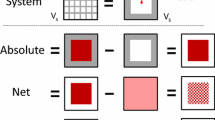Abstract
The influence of the electron spectrum of transition metals on the hydrogen absorption process is considered. An absorption model is proposed where electrons, followed by protons, from adsorbed molecules or atoms of hydrogen transit into the metal. In terms of this model, the driving force of the absorption process ΔX is equal to the difference of the total electron energies in a hydrogen atom and in a metal at the Fermi level: ΔX = E H − (E F + A work). The equilibrium state in the absorption process corresponds to the equation 13.53 = E F + A work, which makes it possible to find the Fermi energy of transition metals and the valence of hydrogen absorbing metals, to define the molecular formula of hydrides, and to calculate the maximum hydrogen content in hydride phases. The hydrogen content in the composition of hydrides is shown to decrease in approaching the middle of the transition-metal rows. In groups, on the contrary, the hydrogen content grows as the atomic weight of metals increases. A good agreement of calculated and experimental compositions of hydride phases is found for the transition metals whose d band is less than half-filled with electrons.
Similar content being viewed by others
References
Mikheeva, V.I., Gidridy perekhodnykh metallov (Hydrides of Transition Metals), Moscow: Akad. Nauk SSSR, 1960.
Mackay, K., Hydrogen Compounds of the Metallic Elements, New York: Barnes and Noble, 1966; Moscow: Mir, 1968.
Verbetskii, V.N. and Mitrokhin, S.V., Hydrides of Intermetallic Compounds—Synthesis, Properties, and Application for Hydrogen Collection, Alternativnaya Energetika Ekologiya, 2005, no. 10, p. 30.
Dergachev, Yu.M., Hydrogen Absorption by Transition Metals, Neorg. Mater., 2006, vol. 42, no. 2, pp. 147–150 [Inorg. Mater. (Engl. Transl.), vol. 42, no. 2 p. 112].
Gibb, T.R.P., Jr., Primary Solid Hydrides, in Progress in Inorganic Chemistry, New York: Interscience Publishers, 1962, vol. 3, p. 315.
Blatt, F.J., Schroeder, P.A., Foiles, C.L., and Greig, D., Thermoelectric Power of Metals, New York: Plenum, 1976; Moscow: Metallurgiya, 1980.
Author information
Authors and Affiliations
Additional information
Original Russian Text © Yu.M. Dergachev, 2009, published in Neorganicheskie Materialy, 2009, Vol. 45, No. 8, pp. 930–933.
Rights and permissions
About this article
Cite this article
Dergachev, Y.M. A model of hydrogen absorption by metals. Inorg Mater 45, 863–866 (2009). https://doi.org/10.1134/S002016850908007X
Received:
Accepted:
Published:
Issue Date:
DOI: https://doi.org/10.1134/S002016850908007X




